

Good News and Bad News at Hanford, America’s Most Polluted Site. It’s a new year and new administration, but the strong radioactive stench is the same out at Hanford in eastern Washington, home of the world’s costliest environmental cleanup.
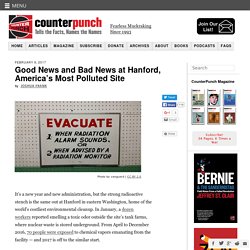
In January, a dozen workers reported smelling a toxic odor outside the site’s tank farms, where nuclear waste is stored underground. From April to December 2016, 70 people were exposed to chemical vapors emanating from the facility — and 2017 is off to the similar start. Toxic odors at an old nuclear depot? This would be startling news anywhere else. But this is Hanford after all, where taxpayer money freely flows to contractors despite the snail-paced half-life of their work. No doubt, Hanford is a wreck in search of a remedy, yet the costs covered by American taxpayers appears to be growing exponentially.
Meanwhile, workers on the front lines of the cleanup are often put in situations that are poorly monitored and exceedingly unsafe. Fortunately, there is a bit of good news in his heap of radioactivity. Armed Ships Embark on Secretive Plutonium Mission From Japan to the U.S. Two armed ships set off from the northwest of England this week to sail round the world to Japan on a secretive and controversial mission to collect a consignment of plutonium and transport it to the U.S.
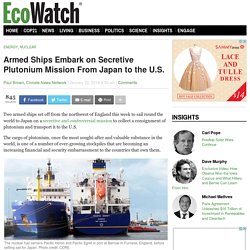
The cargo of plutonium, once the most sought-after and valuable substance in the world, is one of a number of ever-growing stockpiles that are becoming an increasing financial and security embarrassment to the countries that own them. So far, there is no commercially viable use for this toxic metal and there is increasing fear that plutonium could fall into the hands of terrorists or that governments could be tempted to use it to join the nuclear arms race.
All the plans to use plutonium for peaceful purposes in fast breeder and commercial reactors have so far failed to keep pace with the amounts of this highly-dangerous radioactive metal being produced by the countries that run nuclear power stations. The Great Lakes and a High-Level Radioactive Nuke Waste Dump Don't Mix. As if the Great Lakes didn’t have enough nuclear nightmares to deal with, now the Wisconsin state legislature is poised to repeal a 33-year-old ban on new atomic reactor construction.
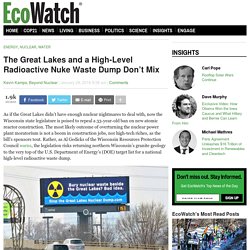
The most likely outcome of overturning the nuclear power plant moratorium is not a boom in construction jobs, nor high-tech riches, as the bill’s sponsors tout. Rather, as Al Gedicks of the Wisconsin Resources Protection Council warns, the legislation risks returning northern Wisconsin’s granite geology to the very top of the U.S. Department of Energy’s (DOE) target list for a national high-level radioactive waste dump. The 14,000-year-old Great Lakes, formed by the melting glaciers of the last Ice Age, serve as the drinking water supply for 40 million people in eight U.S. states, two Canadian provinces and a large number of Native American First Nations. This dome in the Pacific houses tons of radioactive waste – and it's leaking. Black seabirds circle high above the giant concrete dome that rises from a tangle of green vines just a few paces from the lapping waves of the Pacific.
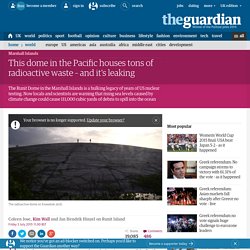
Half buried in the sand, the vast structure looks like a downed UFO. Frackers Are Pumping Nuclear Waste into Your Backyard. By Aaron Dykes and Melissa Melton| *Wake Up World Editor’s Note: Once in a while we hear news of local governments, companies & communities debating where to dispose of various types of trash & waste, nuclear and non-nuclear.
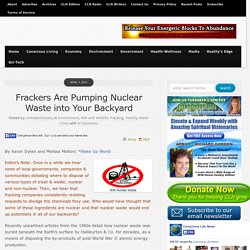
Then, we hear that fracking companies consistently resisting requests to divulge the chemicals they use. Who would have thought that some of those ingredients are nuclear and that nuclear waste would end up potentially in all of our backyards? Radioactive leaks found at 75% of US nuke sites. Steam rises from cooling towers at Exelon Corp.'s nuclear plant in Byron, Ill., March 16, 2011.

AP Photo BRACEVILLE, Ill. - Radioactive tritium has leaked from three-quarters of U.S. commercial nuclear power sites, often into groundwater from corroded, buried piping, an Associated Press investigation shows. Fracking Used to Inject Nuclear Waste Underground for Decades. Aaron Dykes and Melissa Melton, GuestsWaking Times Unearthed articles from the 1960s detail how nuclear waste was buried beneath the Earth’s surface by Halliburton & Co. for decades as a means of disposing the by-products of post-World War II atomic energy production.
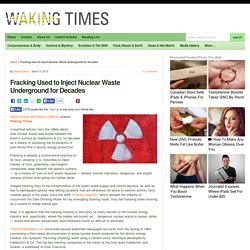
Fracking is already a controversial practice on its face; allowing U.S. industries to inject slurries of toxic, potentially carcinogenic compounds deep beneath the planet’s surface — as a means of “see no evil” waste disposal — already sounds ridiculous, dangerous, and stupid anyway without even going into further detail. Now, it is apparent that the fracking industry is also privy to many secrets of the nuclear energy industry and, specifically, where the bodies are buried, err… dangerous nuclear waste is buried, rather — waste that atomic researchers have otherwise found so difficult to eliminate.
Teaming up with the U.S.